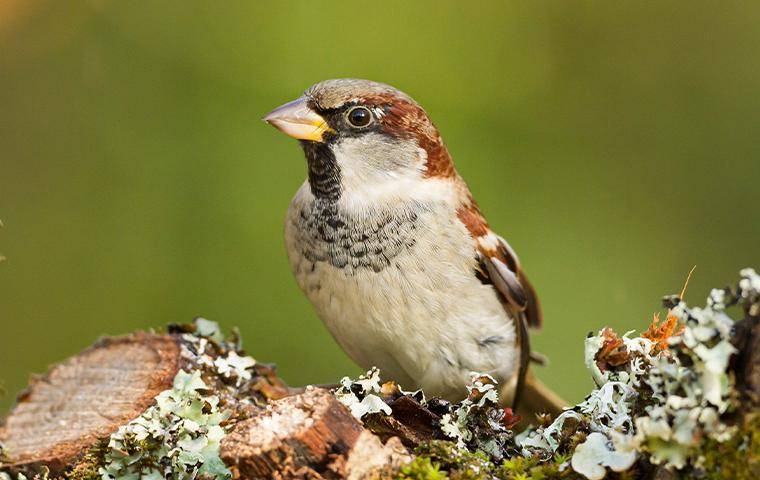SPARROWS AS A POTENTIAL PEST BIRD
General Overview of the Sparrow
The sparrow is a small bird that primarily nests on buildings, on or in homes, and trees. While these birds can be wonderful because they not only eat seeds but also consume large quantities of small, potentially annoying insects, they can also be very messy and hazardous little creatures depending on where they make their nests. If you are having difficulty with the sparrow, it might be a good idea to contact Alliance your New Jersey wildlife expert management to discuss options for safe removal of the bird to prevent any damage to your home or illness to your loved ones and neighbors.
The majority of pill bugs are found in the central and northern areas of the United States. Of the species found, there are about 4,000 known types throughout the world.

History, Nesting, Reproduction, And Other General Behaviors Of The Sparrow
Sparrows were brought to America from England because of their ability to modulate populations of caterpillars that can be very harmful and destructive to ornamental, shade, and decorative trees, shrubs, and other plants. Beyond the fact that these birds are overpopulated in America and even some regions of Canada due to their ability to compete and scavenge for food extremely effectively even in harsh climates, they still pose a large risk to homeowners and buildings due to their problematic nesting tendencies.
The Sparrow will mate beginning in January and usually continue throughout the later part of July. While this species is not particularly territorial, the male will be especially protective of the nest. This can be problematic while mowing, trimming, or shaping landscaping, or if children or individuals get to close to the nest. The Sparrow can tend to act out in defense of the nest, diving and squawking at the person in close proximity to their home or young. When young are present in the nest, generally beginning in March and continuing through the end of August, these protective behaviors are usually at a heightened state and one should be more cognizant of areas where the birds are inhabiting to reduce risk for injury.
Additionally, the diet of Sparrows consists mostly of smaller seeds and insects. While they typically forage for seeds on the ground or at a posted bird feeder, the Sparrow is notorious for being a pest to farmers. Anyone growing wheat, oats, or corn is susceptible to having Sparrows ruin a crop by eating the produce or poking the husk and covering, making the produce susceptible to water, mold development, or the infiltration into produce no longer protected from other pests and bugs. It is helpful to note that during drier months, the Sparrow will transition to eating pesky bugs and spiders. Again during feeding, especially during mating season or when the young are present, Sparrows will be very aggressive. If a feeder is posted, the bird can be very protective of the area to humans, cats, dogs, or other wildlife in the area.
The behavior exhibited by the Sparrow that raises the most concern is the nesting habits. Initially, the concern is that the Sparrow can be very aggressive and competitive with other birds for a nesting site. This can potentially cause native birds to an area to be pushed out into habitats that they might not be suited for. It is important to preserve and assist native birds in achieving their natural nesting habits. Again, this might be a time where it is appropriate to contact Alliance your local wildlife management to evaluate the bird pressure.
Controlling and Mediating the Nesting Behavior of the Sparrow
As stated above, nesting behaviors of the Sparrow can be mediated by repetitive surveillance and removal of nesting materials from a site. While nest building is done primarily in the spring and fall, nesting activity can occur year-round, making this a pesky bird to keep track of. If the Sparrow does happen to get a nest built and eggs are in the nest, incubation extends for about 12 days and after the younglings have hatched, they typically leave the nest in about 15 days. A female will typically lay 4-8 eggs at a time.
Since nests are built year-round, especially near human establishments, it is important to check popular areas for nesting materials. Sparrows are notorious for building a nest in problematic areas such as light fixtures, roof awnings, gutters, and outdoor electrical or phone boxes. This can cause a high risk for electrical fires that can cause substantial damage to your home. Additionally, nests in closed areas such as electrical or phone line boxes and service stations can cause poor conductivity of energy and communication or phone service to your home. Also, due to large litter sizes, year-round development of the species, and the Sparrow’s ability to compete with other native birds, you will probably observe increased droppings around their establishment. This might be unfavorable if it is on surfaces frequently used by humans or pets as bird waste can contain harmful bacteria and illnesses.
To prevent risk to your family and home safety, please contact Alliance Pest Services your wildlife pest bird control agency to maintain and prevent dangerous behaviors exhibited by the Sparrow.
Latest Blogs
Stay informed about pests and pest related issues in your area!
Dangerous Spiders Of Columbia, MD
If three different spiders are placed in front of you and you are told to pick up the harmless one to win a million dollars, would you feel confident enough to do it?
The Easiest Way To Get Bats Off Your Monmouth County Property
Do you see an increased amount of bats around your home lately? Learn the best way to get bats off of your property.
Are The Fleas In Monmouth County Causing You Headaches?
Prevent and treat fleas with help from Alliance Pest Services in Monmouth County.
Request Your Free Quote
"*" indicates required fields


